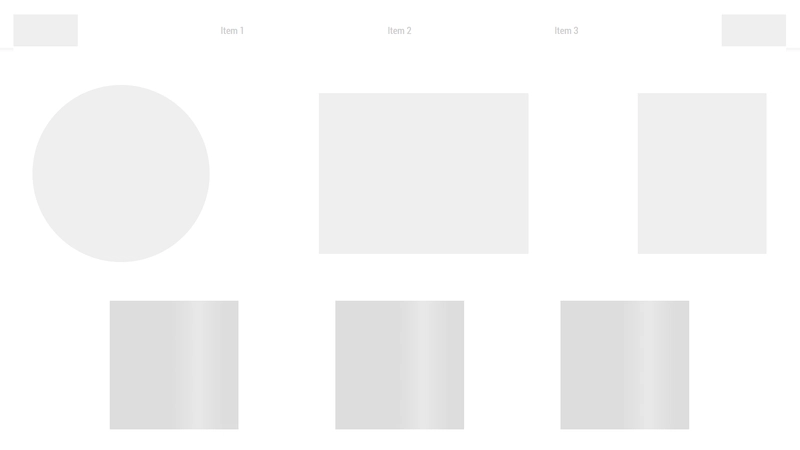使用骨架加载加速你的用户体验☠️
CSS
添加动画
页面加载时消失
你是否见过页面加载时,只看到灰色条而不是实际内容的加载画面?这种加载画面被称为骨架加载画面,Facebook、Google、Slack、YouTube、Dev.to 等公司都在使用这种画面。
在本文中,我们邀请了 80 位参与者,让他们分别评估自己在看到空白页、骨架页和旋转页时的加载时间。他们认为骨架页最快,其次是旋转页,最后是空白页。让我们一起来创建一个骨架页吧!😀
我们将要构建的内容(0.5 视图):
CSS
您可以使用图像来显示骨架,但这会产生额外的数据开销。而且它缺乏响应性。更好的选择是纯粹使用 HTML 和 CSS 来构建屏幕。
在此示例中,我们将为网上商店构建一个骨架屏幕。该骨架屏幕将包含以下内容:
- 包含 5 个项目的导航栏
- 带有一个圆圈和两个正方形的标题
- 3 个产品
如果您想知道我正在使用的奇怪的 CSS 命名约定是什么,我尝试对我的 CSS 使用BEM命名约定!
让我们从设置 HTML 开始,此部分应放在正文的第一个项目处:
<section class="skeleton">
<div class="skeleton__navbar">
<div class="skeleton__nav-item"></div>
<div class="skeleton__nav-box">
<div class="skeleton__nav-text">Item 1</div>
<div class="skeleton__nav-text">Item 2</div>
<div class="skeleton__nav-text">Item 3</div>
</div>
<div class="skeleton__nav-item"></div>
</div>
<div class="skeleton__header">
<div class="skeleton__circle"></div>
<div class="skeleton__img"></div>
<div class="skeleton__info"></div>
</div>
<div class="skeleton__products">
<div class="skeleton__product"></div>
<div class="skeleton__product"></div>
<div class="skeleton__product"></div>
</div>
</section>
然后我们创建一个单独的 CSS 文件,将其放在文档的头部,这样骨架 div 和 css 就会在页面的其余部分之前加载。
我们的骨架的起始样式:
.skeleton {
z-index: 100;
position: fixed;
left: 50%;
transform: translate(-50%, 0);
width: 100%;
height: 100%;
background-color: white;
}
@media (min-width: 1200px) {
.skeleton {
max-width: 1200px;
}
}
让我们添加一些原始 CSS 变量和导航栏:
:root {
--grey: #eee;
--text: #ccc;
}
.skeleton {
z-index: 100;
position: fixed;
left: 50%;
transform: translate(-50%, 0);
width: 100%;
height: 100%;
background-color: white;
}
@media (min-width: 1200px) {
.skeleton {
max-width: 1200px;
}
}
.skeleton__navbar {
width: 100%;
height: 100px;
background: white;
display: flex;
align-items: flex-end;
justify-content: space-between;
}
.skeleton__nav-item {
width: 100px;
height: 50px;
background-color: var(--grey);
}
.skeleton__nav-box {
height: 50px;
display: flex;
flex-grow: 1;
justify-content: space-evenly;
align-items: center;
}
.skeleton__nav-text {
color: var(--text);
}
然后我们将用渐变替换变量并添加其他元素。
:root {
--gradient: linear-gradient(90deg, #ddd 0px, #e8e8e8 40px, #ddd 80px);
--grey: #eee;
--text: #ccc;
}
.skeleton {
z-index: 100;
position: fixed;
left: 50%;
transform: translate(-50%, 0);
width: 100%;
height: 100%;
background-color: white;
}
@media (min-width: 1200px) {
.skeleton {
max-width: 1200px;
}
}
.skeleton__navbar {
width: 100%;
height: 100px;
background: white;
display: flex;
align-items: flex-end;
justify-content: space-between;
}
.skeleton__nav-item {
width: 100px;
height: 50px;
background-color: var(--grey);
}
.skeleton__nav-box {
height: 50px;
display: flex;
flex-grow: 1;
justify-content: space-evenly;
align-items: center;
}
.skeleton__nav-text {
color: var(--text);
}
.skeleton__header {
margin-top: 2rem;
width: 100%;
display: flex;
align-items: center;
justify-content: space-between;
padding: 2rem;
}
.skeleton__circle {
width: 275px;
height: 275px;
background-color: var(--grey);
border-radius: 50%;
}
.skeleton__img {
width: 325px;
height: 250px;
background-color: var(--grey);
}
.skeleton__info {
width: 200px;
height: 250px;
background-color: var(--grey);
}
.skeleton__products {
margin-top: 2rem;
display: flex;
justify-content: space-evenly;
}
.skeleton__product {
width: 200px;
height: 200px;
background-color: var(--grey);
}
好了,基本骨架搞定!接下来添加动画
添加动画
对于动画,我们需要添加一个随时间改变位置的渐变。
:root {
--gradient: linear-gradient(90deg, #ddd 0px, #e8e8e8 40px, #ddd 80px);
--animation: shine 1.6s infinite linear;
}
.skeleton__product {
width: 200px;
height: 200px;
background-image: var(--gradient);
animation: var(--animation);
background-size: 300px;
}
@keyframes shine {
0% {
background-position: -100px;
}
40%,
100% {
background-position: 200px;
}
}
现在将它附加到其余元素,我们就完成了!
:root {
--gradient: linear-gradient(90deg, #ddd 0px, #e8e8e8 40px, #ddd 80px);
--grey: #eee;
--text: #ccc;
--animation: shine 1.6s infinite linear;
--animation-header: shine-header 1.6s infinite linear;
}
.skeleton {
z-index: 100;
position: fixed;
left: 50%;
transform: translate(-50%, 0);
width: 100%;
height: 100%;
background-color: white;
}
@media (min-width: 1200px) {
.skeleton {
max-width: 1200px;
}
}
.skeleton__navbar {
width: 100%;
height: 100px;
background: white;
display: flex;
align-items: flex-end;
justify-content: space-between;
}
.skeleton__nav-item {
width: 100px;
height: 50px;
background-image: var(--gradient);
animation: var(--animation);
background-size: 275px;
}
.skeleton__nav-box {
height: 50px;
display: flex;
flex-grow: 1;
justify-content: space-evenly;
align-items: center;
}
.skeleton__nav-text {
color: var(--text);
}
.skeleton__header {
margin-top: 2rem;
width: 100%;
display: flex;
align-items: center;
justify-content: space-between;
padding: 2rem;
}
.skeleton__circle {
width: 275px;
height: 275px;
background-image: var(--gradient);
animation: var(--animation-header);
background-size: 300px;
border-radius: 50%;
}
.skeleton__img {
width: 325px;
height: 250px;
background-image: var(--gradient);
animation: var(--animation-header);
background-size: 300px;
}
.skeleton__info {
width: 200px;
height: 250px;
background-image: var(--gradient);
animation: var(--animation-header);
background-size: 300px;
}
.skeleton__products {
margin-top: 2rem;
display: flex;
justify-content: space-evenly;
}
.skeleton__product {
width: 200px;
height: 200px;
background-image: var(--gradient);
animation: var(--animation);
background-size: 300px;
}
@media (max-width: 1200px) {
.skeleton__navbar,
.skeleton__header,
.skeleton__products {
flex-direction: column;
}
.skeleton__navbar {
align-items: flex-start;
}
.skeleton__nav-box,
.skeleton__nav-text,
.skeleton__img,
.skeleton__info,
.skeleton__products {
display: none;
}
.skeleton__nav-item {
width: 100%;
}
@keyframes shine {
0% {
background-position: -100px;
}
40%,
100% {
background-position: 200px;
}
}
@keyframes shine-header {
0% {
background-position: -100px;
}
40%,
100% {
background-position: 270px;
}
}
页面加载时消失
接下来,我们必须在页面加载时显示骨架,并在页面准备好时将其删除。
首先将主体设置为具有内联样式的隐藏溢出,因此它会在所有其他样式表之前加载:
<body style="overflow: hidden;">
然后在你的主 JavaScript 文件中,为窗口添加一个 EventListener,用于监听页面加载。加载完成后,移除骨架,并将溢出部分归还给主体!😄
window.addEventListener("load", () => {
document.body.style.overflow = "visible";
elements.skeleton.style.display = "none";
});
就这些!祝你搭建骨架愉快!✌️
请务必关注我以获取更多技巧。🧠
文章来源:https://dev.to/sanderdebr/speed-up-your-ux-with-sculpture-loading-18ja 后端开发教程 - Java、Spring Boot 实战 - msg200.com
后端开发教程 - Java、Spring Boot 实战 - msg200.com
